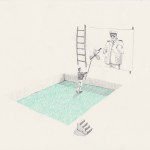The crudely amped-up art market built by the likes of Gagosian, Zwirner, and the auction houses has overwhelmed critical dialogue. But are they the only culprits? In “Bill by Bill” a solo exhibition at Charlie James Gallery, William Powhida blames artists themselves–Hirst, Richter, Koons, Guyton, and uber-artist wannabes–for their self-defeating complicity in a woefully corrupt system that has made a handful of participants fabulously wealthy while leaving everyone else barely able to pay the rent.
“After years of going to art fairs intensive market research ‘Bill by Bill’ represents a decisive breakthrough for the artist into the fields of sculpture and painting by creating unique variations on some of the dominant formulas trends in contemporary art,” the press release sardonically reads. “‘Bill by Bill’ brings together classic Modernist forms with bleeding edge post-studio, conceptually-based (footnote: this does not mean conceptual) practices to create a mercenary stunning vision of contemporary art.”
Enlisting assistants, family and friends to create low-budget versions of the most ubiquitous art fair art, from hard-edge abstract paintings, large-scale digital prints on canvas, and casual materialist paintings to discrete sculptural objects (tastefully arranged on a shelf), neon text pieces, and shiny geometric sculpture, Powhida masterfully spoofs the full range of methods artists have used to produce the massive amount of art objects that high-end galleries need to lard art fair booths and gallery outposts around the world.
overindulged 1% with the more modest material explorations of
underrepresented
artists, particularly those of his friends in Bushwick. His larger point stands, however. It is not only the frenzied, dollarized ignorance of collectors that is responsible for turning artists into soulless careerists who
oversee small armies of assistants and outsource production.
Powhida’s exhibition, grounded in satire, shows that artists, to a
significant degree, have brought it on themselves.
“William Powhida: Bill by Bill,” Charlie James Gallery, Los Angeles, CA. Through June 8, 2013.
Related posts:
#class demonstrated the unequivocal power of social media…but now what? (2010)
NY Times Art in Review: Powhida, Katz, Minter (2009)




















I love Bill Powhida! One of the best artists around and definitely the best critic – he's long overdue for a book.
Hi, Sharon — and thanks a lot for highlighting Powhida's work and this show. Looks like a delicious sendup of the attempt at a money-making enterprise that is our current art-selling system at its top. Making amateurs, friends and family his assistants, is a fitting sarcastic touch (as well as, I'm sure, making it even more fun for the artist himself 😉 .
Satire on, and assigning the blame for the failings of our art system is a time-honored tradition; making no prescription for how to fix it — or even whether it's fixable at all — is also very common. Of course, it's been (well) said that the best comment on a painting is another painting!.. So kudos to Bill for doing it so well!..
Still, are we, artists, not all mimicking the values of our greater society, when collaborating in sustaining this art system that we have all created..?
The prescription of how to change this system then would lie in artists leading the societal change, rather than reflecting its present values (of commodification, etc.)
Best always, >>PHILIP<<
It is interesting that some artists (painters, mostly)continually worry about art as "commodity". Yes, certain living artists sell work for large amounts while others receive large commissions to make new work. Many more artists, however, are simply making their work and living modestly. Why should these artists be made to feel that they need to become art social workers/activists in order to protest the big money makers and art sellers? Why the guilt complex about making art (and painting in particular)? Film makers and writers exist in the same kind of commodity world but aren't constantly questioning whether what they are doing is free of the consumer mentality.